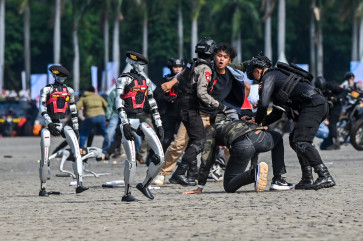Popular Reads
Top Results
Can't find what you're looking for?
View all search resultsPopular Reads
Top Results
Can't find what you're looking for?
View all search resultsA great Zen master autobiography
Chan (aka Zen) is often perceived as somewhat mysterious and inaccessible because its practice is almost unknown to outsiders and sometimes to even Buddhists themselves
Change text size
Gift Premium Articles
to Anyone
Chan (aka Zen) is often perceived as somewhat mysterious and inaccessible because its practice is almost unknown to outsiders and sometimes to even Buddhists themselves.
Originating from China, Chan spread over the centuries to Japan (where it is known as Zen), Vietnam (where it is called Thien) and Korea (Son).
Chan is a sect of Buddhism, where Bodhidharma was the first Chan patriarch and in the 28th generation of a lineage that began with the Sakyamuni Buddha. According to the Chan tradition, lineage is crucial to the preservation of the authenticity of the teachings.
Only after being confirmed by his own Chan master as the heir to his Dharma (teachings) can one become a Chan Master himself. For this reason there are very few Chan Masters, and the practice has remained virtually inaccessible to outsiders.
Most people know of Chan from stories. A classic example is the story where Chan Master Bodhidharma asks his disciple Huike, “What is it you seek?”
Huike answers, “Open the gate of the Dharma and save all beings. But my mind has no peace yet. Please put it to rest.”
Bodhidharma replies, “Bring me your mind, I will put it to rest.”
To which Huike says, “I have searched for my mind, but I can’t find it.”
“There,” Bodhidharma replied, “I have completely put it at rest for you.”
Upon hearing these words, Huike was enlightened.
This simple and direct encounter is typical of stories depicting the essence Chan practice: Awareness. Chan teachings and practice are described as “not depending on words and letters, but pointing directly to the mind.”
However, Chan encounters are quite confusing if we take them at face value without looking at the insights implied by the words. Words have limitations in capturing the essence of Chan, but words are a tool of communication. Not surprisingly, misperceptions about Chan are common. And again, as a result, the encounters are intriguing to outsiders.
For those who are interested in Chan, this autobiography provides a glimpse through the life story of Master Sheng Yen who was a living embodiment of Chan.
To Chan practitioners all over the world, Master Sheng Yen needs no introduction. He was the greatest Chan Master of this century and was from the 62nd generation of the Chan lineage from Bodhidarma, or the 90th generation after Sakyamuni Buddha.
In 2001, the United Nations (UN) recognized Master Sheng Yen as one of the world’s highest spiritual leaders and appointed him as one of the chairmen of the World Council of Religious Leaders, an official unit of the United Nations that aids the UN Secretary-General on religious matters.
In Taiwan, the organization he established, Dharma Drum Mountain, is one of the Four Heavenly Kingdoms, the four most powerful and richest monasteries in Taiwan. Master Sheng Yen, who passed away in February last year, was also highly regarded by other prominent Buddhist leaders. His Holiness the Dalai Lama once said “Listening to Master Sheng Yen’s presentation of Chan Buddhist teachings, my immediate and very profound feeling is that I am listening to words of wisdom from an experienced and great practitioner.”
Meanwhile, Master Thich Nhat Hanh, who some time ago appeared on the Oprah Winfrey Show, said, “Chan Master Sheng Yen is a great teacher. I feel privileged to be his friend, and admire what he has done for Buddhism in the East as well as the West.”
This autobiography is easy to digest, and with its short chapters it flows smoothly. There is no preaching about Buddhism. Instead it depicts real situations: monks who sell their services for money, get into trouble with alcohol and women, and so on.
The autobiography tells the intriguing story of a weak and sickly child from a very poor family in Shanghai who eventually becomes the leading force in the revival of Chinese Buddhism, despite the fact that he was regarded as mentally deficient during his school years.
The English version of this book is the world’s first autobiography written by a Chan Master. This book is considered a breakthrough, as it unveils some of the mystery surrounding Chan, through the life of a great Chan master himself. The most touching part of the this life journey is when the author left his respectable position in Taiwan and chose to start spreading Chan in the West, living as a homeless person (and a Buddhist teacher) in New York City, and how his poor and homeless disciples teach him how to survive.
“My disciples taught me how to find discarded fruit and bread at the back of convenience stores and food markets. We would go to markets at night to pick up discarded vegetables; yams, potatoes and cabbages that were ugly-looking but still good.”
When you visit the multi-billion dollar Dharma Drum Mountain, an international Buddhist education center that Master Sheng Yen established in Taiwan, with operations around the world, it is difficult not to have a deep respect for his persistence and determination to remain focused on his path, in spite of being a homeless monk.
“I wandered through the city, a monk in old robes, sleeping in doorways, nodding with the homeless through the nights in coffee shops, foraging through dumpsters for fruit and vegetables.”
And yet, he says, “The United States is such a wonderful place — everywhere we could pick up useful things for free.” This monk had a witty side and his comments make the book an enjoyable read.
He also talks about the different phases in his life journey: leaving his family to become a Chan Buddhist monk at the age of 13; serving 10 years in the military; being the victim of an attempted poisoning and organ theft; practicing meditation to the point of his own enlightenment; his six-year solitary retreat in a mountain; his doctoral study in Japan, etc.
Master Sheng Yen was a prolific writer, producing more than 100 books, some of which have been translated into more than 12 languages. Through his work, he spread the teachings of Chan, painting a down-to-earth picture of Chan. And through the systematic methods he developed, Chan has become more and more accessible to millions of Chan practitioners around the world.
Jejak Langkah di Atas Salju is the Indonesian version of Footprint in the Snow. It is the result of a collaborative work of members of the Indonesian Chan Community, established by the direct disciples of Master Sheng Yen in Indonesia. You can also flip through the book to enjoy photos of the Indonesian Chan practitioners at the back.
Now, Chan meditation practice is no longer inaccessible.
The writer is a meditation practitioner
Jejak Langkah di atas Salju
Chan Master Sheng Yen
Suwung, Yogyakarta
Pages 325










